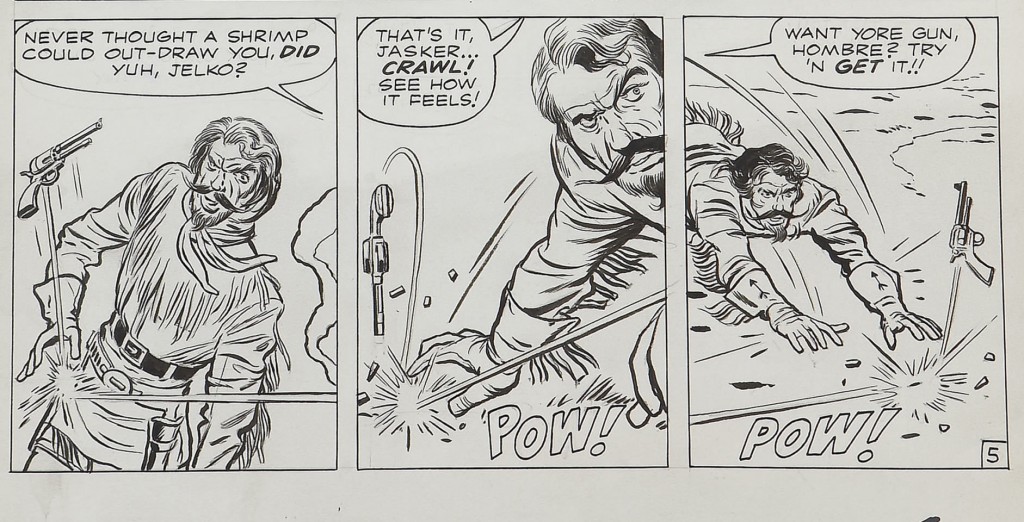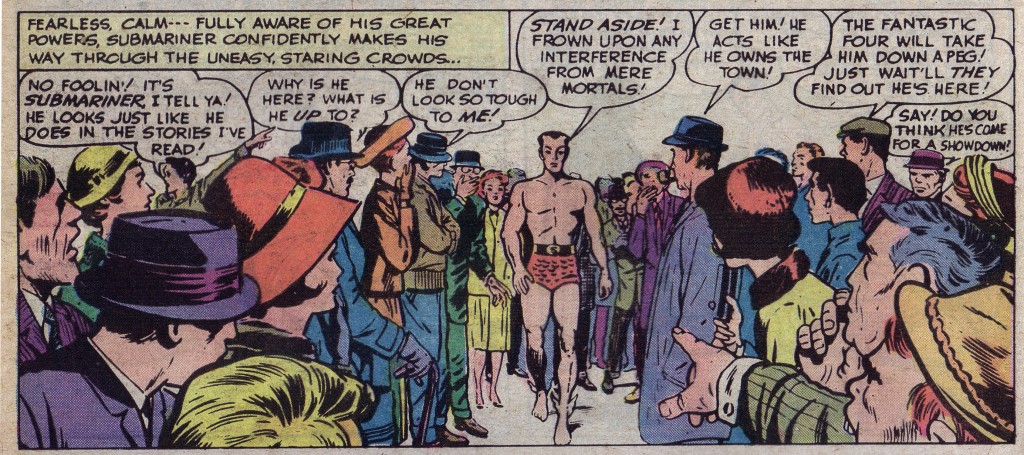One of the first Jobs that Jack Kirby had was working as an in-betweener for the Max Fleischer Animation Studios. The nature of the job was to provide the action in-between the animation cells drawn by another artist. As the illusion of movement in films is provided by a sequence of frames per second, Kirby learned an important lesson from the experience with Fleisher’s studio. What if one applied the same concept to sequential art? How much more dynamic would your work be if you followed up an action shot with a series of near continuous motion?
Returning again to Scott McCloud’s book Understanding Comics, we encounter the concept of closure. This term describes the adjustment that our brain makes when confronted by a series of panels that are designed to tell a story. We see these panels individually at first, but closure allows us to make a connection between them in order to make the story cohesive.
If the panels above contained disconnected images, this would make closure more difficult, as our brains would have to work hard to relate them to one another. As it is, Kirby gives us a near continuous flow of action, as we see Jelko’s gun first shot from his hand, and then repeatedly whisked away by the Rawhide Kid’s bullets.
If one thinks about this, the choice of which panel transition to make is nearly infinite, but it is the choice that sets the pacing of the story. Depending upon the pacing, a story can be told in five pages or fifty. Of course the flow of the narrative alone can make a non sequitur more coherent, but looking at Kirby’s work, one can see how much more effective a story can be when a good deal of intelligence is applied to the choice of sequential images.
One of Kirby’s most amazing action sequences is this Captain America page from Tales of Suspense #85. Cap is fighting a French Savate kickboxing master named Batroc, who gives as good as he gets in this epic duel. Here again is action to action sequencing at its finest as Batroc rushes Cap with rear leg extended backwards towards the viewer, In the next panel we see that same leg kicking fore ward vainly as Cap connects with a smashing right hook and then follows up with a shield bash. Relying on his legs as usual, Batroc counters with a leg sweep, taking Cap down to the mat. Our hero retaliates with a chop to the head and finishes the villain off, demonstrating the superiority of good old American fisticuffs.
The point is that closure enables us to follow the action as if it was continuous, and Kirby’s amazing ability as an in-betweener is seen in his choices. The continuity from panel to panel is certainly not anything close to a complete follow through of the previous shot’s action, but Kirby always presents us with enough information to make the flow of the action dynamic. For instance, panel five has Cap striking in prone position with his right leg pointing fore ward to the right, which flows into his right leg in panel six as he rises to deliver a right cross to Batroc.
As I’ve mentioned previously, it is possible to depict the flow of time in a single panel nearly as well as in a series of frames. In this shot, we see Prince Namor the Sub-Mariner walking imperiously through a crowd. We follow the procession of talking heads from left to right until we come to Namor’s confident figure in the center. What we are actually seeing here is the upper portion of a circular composition whose extreme left rim is the man with the purple hat. What we observe on the far right is the figure in the yellow hat pointing back at Namor and keeping the focus on him. The remainder of the circle is below the panel border.
It may also be instructive to divide this panel in lattices, which as you may or may not remember is a mathematical physics term referring to a regular, periodic configuration of points, particles or objects throughout an area or space. If we can imagine each figure occupying its own rectangular box or slice, we can easily comprehend the depth of field in this singular panel and the division of space/time herein as well. The main point is that the actions in this panel are not simultaneous but occur in the left to right sequence, just as a series of panels do.
In certain cases, a sequential artist like Kirby needs to convey a moment in time that is instantaneous and cataclysmic. In such cases, Kirby often relies on the art form of collage to depict the sudden shock of such an event. Using his flair for composition, the artist constructs a devastating explosion of a Nazi stronghold, by taking various fragments of unrelated photographs.
The composition gives us the impression of a sudden tremendous up thrust of energy, as the twin mushroom clouds scatter debris in all directions.
We tend to see the collage panel as a separate, tumultuous event because of its photo reality, distinct from the preceding panels. Kirby is as surgically precise as any film editor, as he constructs his visual narratives, and that is why he takes pride first and foremost in his storytelling abilities.
Image 1- Rawhide Kid #28 Original art, Jack Kirby, Stan Lee
Image 2- Tales of Suspense #85, Jack Kirby, Stan Lee
Image 3- Fantastic Four #6, Jack Kirby, Stan Lee
Image 4- Sgt. Fury#13 Original art, Jack Kirby, Stan Lee






Pingback: 11 Facts About Jack Kirby, the Artist Behind the Marvel Universe - E.Y.E